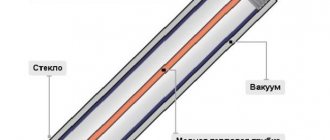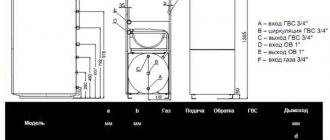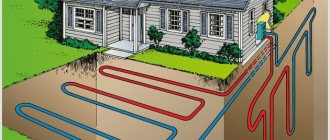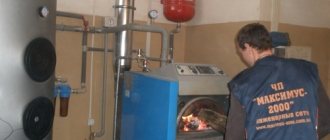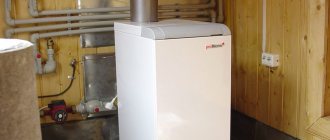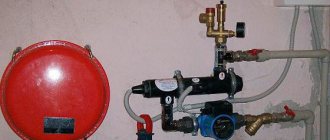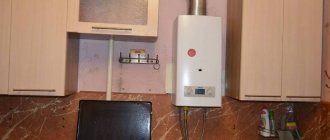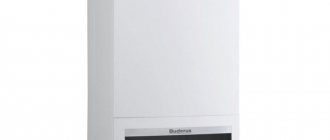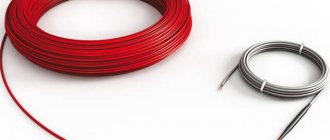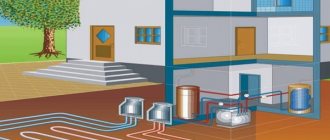Heliosystem... Nowadays, this word no longer seems to surprise anyone. But not many people fully understand what it is. Some “experts” ask the question: “Where is the helium?”, others claim that when designing the system, we forgot to include gel in the estimate, but in fact, a HELIOSYSTEM is just an installed set of equipment capable of converting solar radiation into something useful for us. energy.
Since the appearance of solar energy converters on the Ukrainian market, the corresponding names have been firmly attached to them:
- Photovoltaic system is an installation designed to generate electrical energy.
- Solar system is a set of equipment designed to generate thermal energy.
Although, at root, both types of systems are solar systems.
What is a solar system?
So, a solar system in the classical sense of the word is a set of equipment designed to convert solar energy into thermal energy.
As you know, the sun gives us a huge amount of energy. The task of humanity is to correctly collect this energy. To be precise, the average amount of energy emitted by the sun onto the earth’s surface at the latitude of Kyiv in the summer is 6 kW∙hour/m2 per day.
The first law of thermodynamics states that energy does not come from anywhere and does not disappear anywhere without a trace, but only passes from one state to another.
Purpose of the solar system
The direct task of solar systems is the most efficient conversion of solar radiation energy into heat.
Today, the maximum efficiency of solar systems reaches 95%, which is the highest result compared to other technologies.
Solar systems are used in everyday life for:
- heating water (hot water supply (DHW)),
- heating system support,
- heating the water in the pool.
There is an interesting technology where, using geothermal heat pumps, energy is driven into the ground and then removed from there in winter.
If you use a solar system for hot water supply, heating and heating a swimming pool, the payback period becomes shorter because absolutely all the energy is consumed. If used only for heating water, then a very accurate calculation is needed so that there is no excess energy. If used for heating and hot water supply, then this is actually not very effective, since in the summer there will be a lot of excess energy and a problem with its distribution will arise.
Use of solar systems for enterprises
For heating water in large swimming pools (from 200 m³), solar systems have proven themselves very well. For example, to heat water in a pool with a volume of 980 m³, 37 collectors (1080 tubes) are used.
It is also effective to use solar collectors for hot water supply to hotels and restaurants, where there is a constant supply of hot water and a large heat load. This is good, since the solar collector is always designed for 80% of the thermal load.
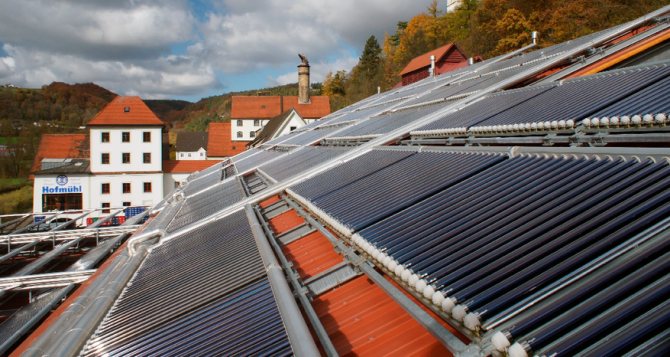
That is, if we want to use a solar system for a house where a family of two lives, it is very difficult to calculate what the heat load will be: today a person will use the shower 2 times, and tomorrow only once. This will be a problem since a full quarter of the energy will not be used.
Therefore, the use of solar systems for large-scale enterprises is more balanced, because water collection is stable.
Solar panels - solar system
We know about the existence of solar power plants, solar-electric cars, and solar towers. Solar, also known as solar system, belongs to this family of energy savers. Many have already appreciated its capabilities by installing it on their suburban area.
The solar system solves several household issues at once, providing hot water supply, heating the house, as well as heating cold water in the pool. The advantages of switching to an alternative system are obvious: you pay less for electricity, you are no longer dependent on fluctuations in energy prices, and the environment becomes cleaner. The main operating link of the solar system is the collector. It is with its help that radiation is absorbed. It is new to many domestic consumers, and it is important to choose the right type correctly. Nowadays flat solar and vacuum tube collectors are widely used. The former are considered more reliable due to their resistance to changes in our climate. Simple plastic models without glazing are beneficial for heating a pool; models with glazing are universal: suitable for hot water supply, heating and even for a swimming pool.
The principle of operation of the collector is as follows: solar radiation hits the absorbing plate and heats it. Heat is transferred to the coolant (water or antifreeze), which heats up to +200 °C. The energy is then transferred through a heat exchanger to the water in the cylinder, where the water remains at a temperature of +95°C until it is used. To comply with safety requirements, a thermo-mixing tap is installed at the water outlet, maintaining a temperature no higher than +55 °C. You will have hot water at home both day and night, since the water heater maintains the temperature for up to four days.
A vacuum tubular collector is more susceptible to the elements than a flat one, but has a higher and more stable efficiency value throughout the year. It is convenient to use in country houses with permanent residence.
To save space, the collector is usually located on the roof, if possible - in the south direction (for the Moscow region). The optimal angle of inclination to the horizon is 30–45°. For installations that support heating, this angle is larger: 45–60°. With this arrangement, the absorbing plate is better illuminated by the sun in the off-season.
Another advantage of the solar system is that after installation it does not require additional maintenance. And the service life is almost unlimited. How much energy can be obtained using the collector and is it enough for all needs? In the summer, the family's need for hot water will be satisfied almost completely. However, in autumn and winter the solar collector works with less intensity. On cloudy days, when there is not enough sunlight and the water in the water heater is cooled to +45 ° C, the heating element or circulation pump automatically turns on to heat the water. Hence the average value is 60% of hot water supply per year. If we are talking about heating, then 10 to 30% of the annual consumption is covered.
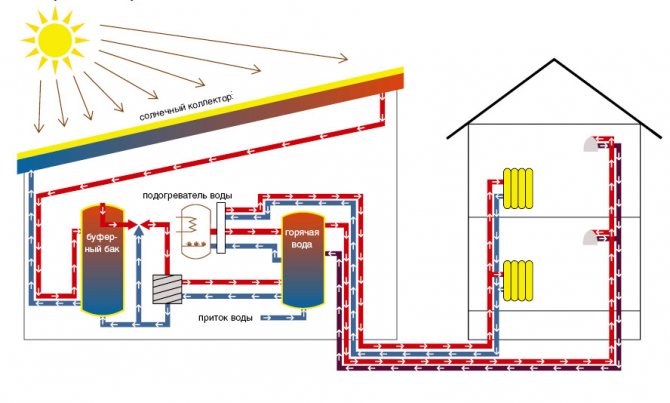
When installing it yourself, it is better to choose a kit that is completely ready for installation and operation. A suitable example is the auroSTEP solar system with a flat-plate solar collector. More precisely, it consists of two entire collectors with a total area of 4.2 square meters. m and a cylinder water heater with two coils. A mounting kit and assembly instructions are also included. This system can be placed on either a flat or pitched roof. Hot water supply – 250 liters. When the system is first started, it may take several hours to heat up the water, the exact amount of time depending on the intensity of solar radiation. The display will show detailed information about the current state of the system: for example, how much solar energy is spent on heating.
A special durable coolant that can withstand temperatures down to –47 °C will help you and your collector survive the harsh winter. On sunny winter days the system will function without interruption.
Composition of the solar system
The standard solar system kit includes the following elements:
- heat generator (solar collector of any type),
- a device that transfers coolant (pump or pressure from an external water supply system),
- heated object (DHW system water, heating system, swimming pool).

Solar system: principle of operation
Let's take a closer look at the operating principle of solar hot water supply systems used in the domestic sector.
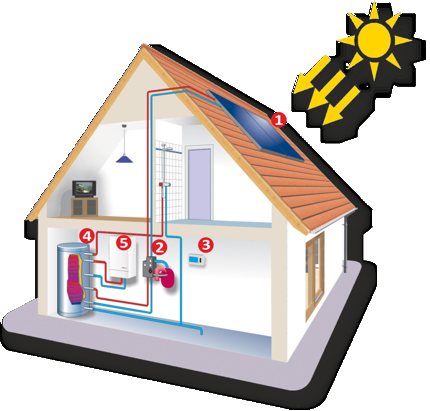
The solar system (solar hot water supply system) includes the main components:
- solar collectors
- pump module with safety group
- controller
- battery tank (water)
- backup energy source
Coolant or water circulates in solar collectors; circulation in the solar system circuit is ensured by a pump or by natural circulation arising from temperature differences. When heated in the solar collector, the coolant transfers thermal energy from the tank to the battery via a heat exchanger. The heat exchanger can be built into the tank as a coil or can be used as a separate element. The water in the tank accumulates thermal energy. This process occurs automatically thanks to a controller that regulates the operation of the pump in the solar system . If necessary, the automation starts a backup energy source.
Solar systemsolar collector
Advantages and disadvantages of using a solar system
Flaws:
- The disadvantage is seasonality. Heating by the sun in winter, or rather its efficiency decreases due to slight insolation.
- The high cost of investment is an initial disadvantage, which quickly turns into a plus. Because the solar system pays for itself very quickly - within 7-8 years.
- The solar system is negatively affected by voltage surges. It happens that the electricity is turned off and the solar system boils. Over time, if several dozen similar boils occur, the system may fail. In this case, it will be necessary to carry out service maintenance, after which the fluid will be refilled (changed) so that the system can operate normally again.
Replacing the solar collector tube. Solar collector design and operating principle
Advantages:
- The undeniable advantage of such a system is the ability to save a significant part of the energy required to heat the required body.
- If calculated correctly, the system should compensate for up to 80% of energy costs in the summer.
- Long service life - 30 years or more.
- Short payback period – 7-8 years or less.
- The solar system includes elements made from glass and aluminum, and for the manufacture of components, materials that are subject to rapid wear are not used.
Quick calculation of solar systems
The easiest way to get a high-quality and professional calculation of a solar system (solar system) is to fill out a short form by going to the address. Within 24 hours you will receive a full calculation, recommendations and a commercial offer for the solar system. You can also independently calculate your system using the calculators and algorithms suggested below.
Using the diagram proposed below, you can easily calculate the approximate configuration of equipment for your needs.
To calculate, you need to go through several steps.
- Decide on the number of hot water consumers
- Determine the approximate amount of water consumed by each member of your family per day
- After these two steps you will get the recommended storage tank volume
- Select the desired degree of replacement of your heat needs with solar energy
- Select the southern or northern region of Ukraine where the system is planned to be located
- Select the planned orientation of the installed collectors
- Select the angle of inclination of the installed collectors
- After completing the last step you will get the approximate number of collectors required
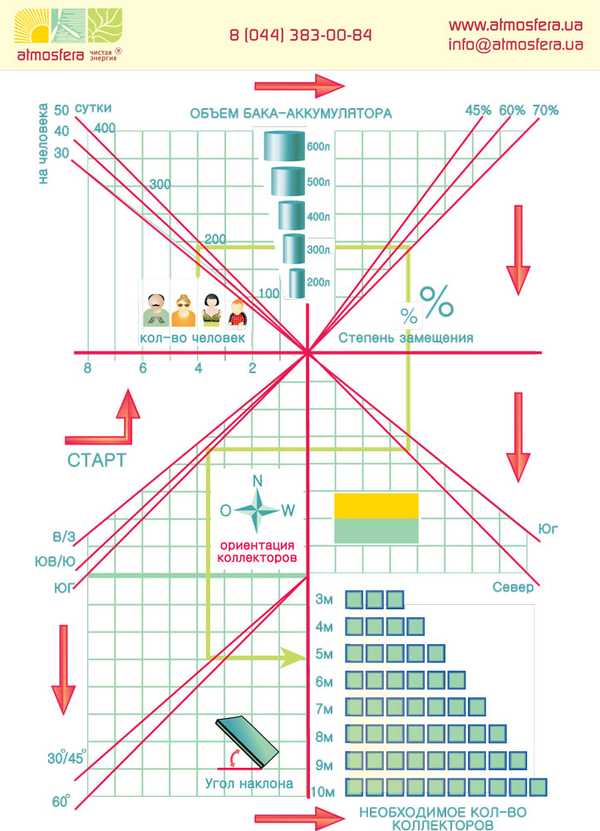
After completing the above steps, you have the required storage tank capacity and the approximate number of collectors. Next, you need to decide whether you will use solar energy as an additional heat source in the heating system. The choice of a storage tank with one or two heat exchangers depends on your decision. To extract heat into the main heating system, you will have a tank with two heat exchangers. With the help of one, heat will be transferred to the water tank, with the help of the second (upper) you will be able to transfer excess heat to the main heating system. Next, to the resulting set you need to add a workstation with a controller, temperature sensors and other automation. Thus, having a set of equipment consisting of a storage tank, the required number of vacuum solar collectors and a workstation with a controller, you can calculate the cost of your system. For a “rough estimate”, 30% is usually added to the cost of equipment for installation work and additional pipes, fittings, insulation, etc. and you receive the full cost of your project.
All that remains is to calculate the payback period of the system. Calculations of costs for hot water supply and heating when using different energy sources are given on the page “Payback periods”. Please note that this table shows data for 2007; today, some energy resources have already risen significantly in price.
For more accurate calculations, creating a project and carrying out other, more complex design work, we ask you to fill out the order form for calculating solar systems. For accurate calculations, it may be necessary for our specialist to visit the site or provide additional plans or photographs of the site on your part.
Efficiency of using solar systems on the territory of Ukraine
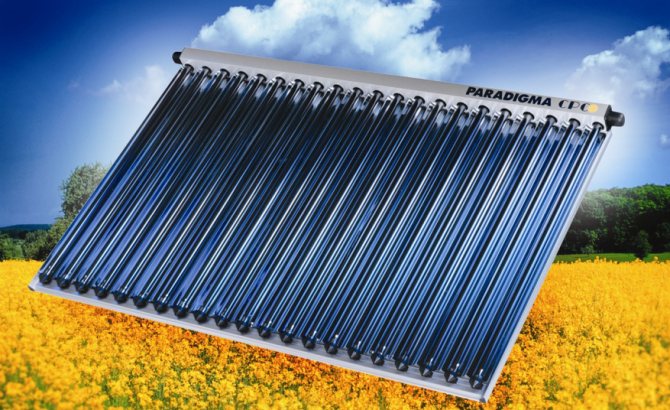
The entire territory of Ukraine, without exception, is suitable for the use of solar systems. That is, even northern regions (for example, Chernigov or Sumy regions) are excellent for using solar collectors on their territory. There is enough solar insolation there. For example, the maximum insolation rate in the Chernigov region is 950 kW∙hour/m², and in the Kherson and Odessa regions it can reach 1400 kW∙hour/m². It follows that it is most effective to use solar systems in the southern regions of the country.
- The feasibility of replacing a gas boiler with a new highly efficient one Previous material
- Exhaust ventilation in an apartment and a private house: features and specifics Next material
